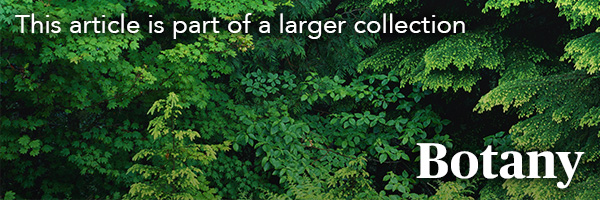Poisonous Plants
Most major groups of PLANTS contain species that can produce toxic reactions in humans and other animals, ranging from mild discomfort to organ damage, and even death. Such poisons may be assimilated by being eaten, inhaled or absorbed through the skin. Some plants that are not poisonous can also be dangerous, including those with sharp parts (eg, thorns, prickles, spines) that may cause physical damage followed by infection.Toxic Properties
Toxic reactions generally are caused by chemical compounds that are produced by plants or absorbed from soil. These compounds produce undesirable physiological responses in individuals or animals. Types of toxins include alkaloids (bitter-tasting, semi-alkaline substances containing nitrogen) that occur throughout plants in the form of soluble organic acid salts; polypeptides and amines, organic substances containing nitrogen; glycosides, compounds that break down to form sugars and toxic aglycones; oxalates, occurring as soluble or insoluble salts; insoluble calcium salts, irritants that are deposited in kidneys; resins or resinoids, which can irritate muscle tissue; and phytotoxins or toxalbumins (protein molecules acting as enzymes), which break down natural proteins, causing ammonia accumulation and protein deficiency. Many plants take up minerals (eg, copper, selenium, lead, molybdenum, nitrates or nitrites) from soils in sufficient quantities to cause poisoning when ingested (eg, by grazing animals).
Allergies
Many people are sensitive to plant substances. Airborne material (eg, FUNGI spores, soil ALGAE, pollen grains) causes hay fever. Pollen, the plant part that produces male gametes, is a serious problem that affects many people. Allergy-inducing pollen is produced by wind-pollinated plant species, which generally produce and release massive amounts of pollen into the environment. In Canada, allergic reactions to pollen in the spring are generally caused by pollen from early flowering tree species; reaction in midsummer is caused primarily by pollen from GRASS species; and autumn reactions are caused by pollen from wind-pollinated herbaceous plants, chiefly RAGWEED. Most of Canada, except for southern parts of Ontario and Québec, is relatively free of ragweed because day length is unsuitable at higher latitudes for the growth of the plant. Pollen allergies rarely kill but can cause substantial discomfort.
Dermatitis
Several plant species (eg, POISON IVY, poison SUMAC, primrose) cause skin irritation (redness, itching or blisters). This irritation is often the result of an allergic reaction induced by contact with a plant-produced compound. Not all people have the same level of sensitivity to dermatitis-inducing plants. Severity also depends on the degree of contact. Temporary discomfort is the result of contact with stinging nettle (genus Urtica), woodnettle (genus Laportea) and the stem hairs of some species of avens (genus Geum). Stinging nettle has tiny hairs with tips that inject various poisons when they touch skin.
Internal Poisoning
Internal poisoning occurs when toxic plant parts are ingested. People generally can avoid eating poisonous plants with appropriate knowledge, but grazing animals may eat them. Animals, however, do learn to avoid poisonous plants. This can be observed in heavily grazed areas where all vegetation except the poisonous species is eaten to the ground. The degree of internal poisoning depends upon several factors, including the type and quantity of the plant eaten, the stage of the life cycle of the plant, and the condition and age of the ingesting person or animal. Some toxic plants are used recreationally as drugs, such as marijuana (Cannabis sativa, family Cannabaceae), which upon inhalation can cause hallucinations, delusions, blurred vision and poor coordination.
Mechanical Injury
While not poisonous, certain plants can cause external or internal physical injury. Many plant species in Canada have sharp, prominent thorns or prickles, including HAWTHORNS (genus Crataegus), ROSES (genus Rosa) and blackberries (genus Rubus) in the rose family (Rosaceae), and THISTLES in the sunflower family. The west coast devil's-club (Oplopanax horridus, family Araliaceae) is spiny throughout and can form impassable thickets. The barbs or awns of grasses (family Poaceae) such as wild barley (genus Hordeum), brome grass (genus Bromus), wild rye (genus Elymus) and needle-and-thread grass (genus Hesperostipa) can stick in the skin, mouth and throat of an animal. Bur-producing plants such as cocklebur (genus Xanthium, family Asteraceae) and burdock (genus Arctium, family Asteraceae) have prickly fruits that can injure the mouth and intestine if swallowed. Mullein (genus Verbascum, family Scrophulariaceae) and crimson and rabbit-foot CLOVERS (genus Trifolium, family Leguminosae or Fabaceae) can form hair balls in the stomach.

 Share on Facebook
Share on Facebook Share on X
Share on X Share by Email
Share by Email Share on Google Classroom
Share on Google Classroom



